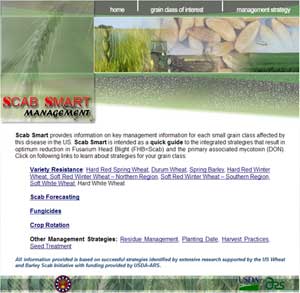United States
September 25, 2009
 The U.S. Wheat and Barley Scab Initiative (UWBSI) launched a new Web site this week to provide producers with information on how to manage Fusarium head blight, commonly known as scab.
The U.S. Wheat and Barley Scab Initiative (UWBSI) launched a new Web site this week to provide producers with information on how to manage Fusarium head blight, commonly known as scab.
Scab Smart is designed to serve as a quick guide to the integrated strategies that result in optimum reduction of scab and its primary associated mycotoxin, deoxynivalenol (DON).
On the site, producers can access information by management strategy or wheat class. Scab Smart’s content will be updated on an ongoing basis as new management information becomes available.
The group has previously reported that infections of scab have reached worrisome levels in several Southern soft winter wheat states due to wet weather.
The new tool is accessible at www.scabsmart.org.
RELATED RELEASE
A ProMED-mail post
<http://www.promedmail.org>
ProMED-mail is a program of the
International Society for Infectious Diseases <http://www.isid.org>
Date: Fri 25 Sep 2009
Source: AgriMarketing, US Wheat & Barley Scab Initiative news release [edited] <http://www.agrimarketing.com/show_story.php?id=56733>
US Wheat & Barley Scab Initiative launch new disease management website
Grain producers and others looking for the latest information on the management of fusarium head blight (scab) now have a valuable new tool.
"Scab Smart" is the name of a just activated website designed to serve as a quick guide to the integrated strategies that result in optimum reduction of fusarium head blight and its primary associated mycotoxin, deoxynivalenol (DON). Scab Smart provides users with 2 ways of accessing information, according to Marcia McMullen, coordinator of the site's development. "You can go directly to the management strategy you're interested in," she explains, "or you can go to the grain class and then to the strategy for that class."
Management strategy categories include variety resistance (by grain class and by state), scab forecasting, fungicides, crop rotation and other strategies (such as residue management, planting date, and harvest practices). The covered grain classes include hard red spring wheat, durum wheat, spring barley, hard red winter wheat, soft red winter wheat (broken down by northern and southern regions), soft white wheat, and hard white wheat.
Scab Smart's content will be updated on an ongoing basis as new management information becomes available. The website can be accessed at <http://www.scabsmart.org> or via the US Wheat and Barley Scab Initiative's site at <http://www.scabusa.org> and clicking on the Scab Smart link.
--
communicated by:
ProMED-mail rapporteur George Robertson
[Fusarium head blight (FHB) can cause yield losses of up to 45 per cent in small grain crops and reduce the grade of harvested grain. The disease may also contaminate the grain with fungal toxins, which can seriously affect livestock. For more information see links below and previous ProMED-mail posts in the archives.
Maps of USA:
<http://www.mapsofworld.com/usa/usa-state-and-capital-map.html> and <http://healthmap.org/r/009V> Pictures Fusarium head blight (FHB) on wheat:
<http://www.nwroc.umn.edu/Cropping_Issues/2005/issue6/
FHB_examples.jpg> and <http://plantsci.sdstate.edu/planthealth/other_images/scab.jpg>
Links
Fusarium diseases of small grains:
<http://www.apsnet.org/online/feature/FHB/Top.html> and <http://www.ag.ndsu.edu/pubs/plantsci/smgrains/pp804w.htm>. - Mod.DHA]